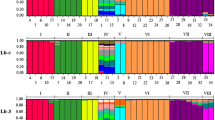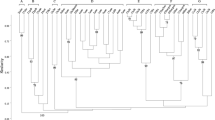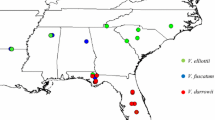Abstract
Cañahua (Chenopodium pallidicaule Aellen) is a poorly studied, annual subsistence crop of the high Andes of South America. Its nutritional value (high in protein and mineral content) and ability to thrive in harsh climates make it an important regional food crop throughout the Andean region. The objectives of this study were to develop genetic markers and to quantify genetic diversity within cañahua. A set of 43 wild and cultivated cañahua genotypes and two related species (Chenopodium quinoa Willd. and Chenopodium petiolare Kunth) were evaluated for polymorphism using 192 microsatellite markers derived from random genomic cañahua sequences produced by 454 pyrosequencing of cañahua genomic DNA. Another 424 microsatellite markers from C. quinoa were also evaluated for cross-species amplification and polymorphism in cañahua. A total of 34 polymorphic microsatellite marker loci were identified which detected a total of 154 alleles with an average of 4.5 alleles per marker locus and an average heterozygosity value of 0.49. A cluster analysis, based on Nei genetic distance, clearly separated from wild cañahua genotypes from the cultivated genotypes. Within the cultivated genotypes, subclades were partitioned by AMOVA analysis into six model-based clusters, including a subclade consisting sole of erect morphotypes. The isolation by distance test displayed no significant correlation between geographic collection origin and genotypic data, suggesting that cañahua populations have moved extensively, presumably via ancient food exchange strategies among native peoples of the Andean region. The molecular markers reported here are a significant resource for ongoing efforts to characterize the extensive Bolivian and Peruvian cañahua germplasm banks, including the development of core germplasm collections needed to support emerging breeding programs.



Similar content being viewed by others
References
Achigan-Dako EG (2008) Phylogenetic and genetic variation analyses in cucurbit species (Cucurbitaceae) from West Africa: definition of conservation strategies. Cuvillier Verlag, Göttingen
Bohonak AJ (2002) IBD (isolation by distance): a program for analyses of isolation by distance. J Hered 93:153–154
Bonifacio A (2003) Chenopodium sp.: genetic resources, ethnobotany, and geographic distribution. Food Rev Int 19:1–7
Di Gaspero G, Peterlunger E, Testolin R, Edwards KJ, Cipriani G (2000) Conservation of microsatellite loci within the genus Vitis. Theor Appl Genet 101:301–308
Dray S, Dufour AB (2007) The ade4 package: implementing the duality diagram for ecologists. J Stat Softw 22:1–20
Evanno G, Regnaut S, Goudet J (2005) Detecting the number of clusters of individuals using the software STRUCTURE: a simulation study. Mol Ecol 14:2611–2620
Excoffier L, Smouse PE, Quattro JM (1992) Analysis of molecular variance inferred from metric distances among DNA haplotypes: application to human mitochondrial DNA restriction data. Genetics 131:479–491
Excoffier L, Laval G, Schneider S (2005) Arlequin (version 3.0): an integrated software package for population genetics data analysis. Evol Bioinform 1:47–50
Flores R (2006) Evaluación preliminar agronómica y morfológica del germoplasma de cañahua (Chenopodium pallidicaule Aellen) en la estación experimental Belen. Universidad Mayor de San Andrés, La Paz
Friedt W, Snowdon RJ, Ordon F, Ahlemeyer J (2007) Plant breeding: assessment of genetic diversity in crop plants and its exploitation in breeding. In: K. Esser UL, W. Beyschlag, J. Murata (eds). Springer, Berlin, pp 151–178
Gade D (1970) Ethnobotany of cañahua (Chenopodium pallidicaule), rustic seed crop of the altiplano. Econ Bot 24:55–61
Gaitan-Solis E, Duque MC, Edwards KJ, Tohme J (2002) Microsatellite repeats in common bean (Phaseolus vulgaris): isolation, characterization, and cross-species amplification in Phaseolus ssp. Crop Sci 42:2128–2136
Galwey NW (1989) Exploited plants—Quinoa. Biologist 36:267–274
Groben R, Wricke G (1998) Occurrence of microsatellites in spinach sequences from computer databases and development of polymorphic SSR markers. Plant Breed 117:271–274
Gumerman G (1997) Food and complex societies. J Archaeol Meth Theor 12:105–139
Höglund J (2009) Evolutionary conservation genetics, 1st edn. Oxford University Press, New York
Huelsenbeck JP, Andolfatto P (2007) Inference of population structure under a Dirichlet process model. Genetics 175:1787–1802
IPGRI, PROINPA, IFAD (2005) Descriptores para cañahua (Chenopodium pallidicaule Aellen). Instituto Internacional de Recursos Fitogenéticos, Roma, Italia; Fundación PROINPA, La Paz, Bolivia; International Fund for Agricultural Development, Roma, Italia
Jarvis DE, Kopp OR, Jellen EN, Mallory MA, Pattee J, Bonifacio A, Coleman CE, Stevens MR, Fairbanks DJ, Maughan PJ (2008) Simple sequence repeat marker development and genetic mapping in quinoa (Chenopodium quinoa Willd.). J Genet 87:39–51
Liu K, Muse SV (2005) PowerMarker: an integrated analysis environment for genetic marker analysis. Bioinformatics 21:2128–2129
Mallory MA, Hall RV, McNabb AR, Pratt DB, Jellen EN, Maughan PJ (2008) Development and characterization of microsatellite markers for the grain Amaranths. Crop Sci 48:1098–1106
Marin W (2002) Distanciamiento entre surcos y plantas en dos ecotipos de kañawa (Chenopodium pallidicaule Aellen) en el Altiplano Norte. Universidad Mayor de San Andrés, La Paz
Marti N, Pimbert M (2007) Barter markets for the conservation of agro-ecosystem multi-functionality: the case of the chalayplasa in the Peruvian Andes. Int J Agr Sustain 5:51–69
Mason SL, Stevens MR, Jellen EN, Bonifacio A, Fairbanks DJ, Coleman CE, McCarty RR, Rasmussen AG, Maughan PJ (2005) Development and use of microsatellite markers for germplasm characterization in quinoa (Chenopodium quinoa Willd.). Crop Sci 45:1618–1630
Morchen M, Cuguen J, Michaelis G, Hanni C, SaumitouLaprade P (1996) Abundance and length polymorphism of microsatellite repeats in Beta vulgaris L. Theor Appl Genet 92:326–333
Muller K, Borsch T (2005) Phylogenetics of Amaranthaceae based on matK/trnK sequences data: evidence from parsimony, likelihood, and bayesian analysis. Ann Missouri Bot Gard 92:66–102
Nei M (1978) Estimation of average heterozygosity and genetic distance from a small number of individuals. Genetics 89:583–590
Nei M, Li WH (1979) Mathematical-model for studying genetic-variation in terms of restriction endonucleases. Proc Natl Acad Sci U S A 76:5269–5273
Nei M, Tajima F (1983) Maximum likelihood estimation of the number of nucleotide substitutions from restriction sites data. Genetics 105:207–217
Ott J (1992) Strategies for characterizing highly polymorphic markers in human gene-mapping. Am J Hum Genet 51:283–290
Pritchard JK, Stephens M, Donnelly P (2000) Inference of population structure using multilocus genotype data. Genetics 155:945–959
Repo-Carrasco R, Espinoza C, Jacobsen SE (2003) Nutritional value and use of the Andean crops quinoa (Chenopodium quinoa) and kañiwa (Chenopodium pallidicaule). Food Rev Int 19:179–189
Repo-Carrasco-Valencia R, de La Cruz AA, Alvarez JCI, Kallio H (2009) Chemical and functional characterization of kañiwa (Chenopodium pallidicaule) grain, extrudate and bran. Plant Foods Hum Nutr 64:94–101
Risi CJ, Galwey NW (1984) The Chenopodium grains of the Andes: Inca crops for modern agriculture. Adv Appl Biol 10:145–216
Rist S (2000) Linking ethics and the market—Campesino economic strategies in the Bolivian Andes. Mt Res Dev 20:310–315
Rodríguez M (2007) Evaluación de las pérdidas de grano y grado de impurezas en cuatro métodos de cosecha de cañahua (Chenopodium pallidicaule Aellen) en la comunidad de Quipaquipani, Viacha. Universidad Mayor de San Andrés, La Paz
Rozen S, Skaletsky H (2000) Primer3 on the WWW for general users and for biologist programmers. In: Krawetz S, Misener S (eds) Bioinformatics methods and protocols: methods in molecular biology. Humana Press, Totowa, pp 365–386
Thiel T, Michalek W, Varshney R, Graner A (2003) Exploiting EST databases for the development and characterization of gene-derived SSR-markers in barley (Hordeum vulgare L.). Theor Appl Genet 106:411–422
Todd JJ, Vodkin LO (1996) Duplications that suppress and deletions that restore expression from a chalcone synthase multigene family. Plant Cell 8:687–699
Vaz ARD, Borba TCD, Brondani C, Rangel PHN, Camargo GSD, Telles MPD, Filho JAF, Brondani RPV (2009) Genetic analysis of a local population of Oryza glumaepatula using SSR markers: implications for management and conservation programs. Genetica 137:221–231
Weir B (1996) Genetic Data Analysis II: Methods for discrete population genetic data. Sinauer Assoc., Inc, Sunderland
Weir BS, Cockerham CC (1984) Estimating F-statistics for the analysis of population-structure. Evolution 38:1358–1370
Woods Páez A, Eyzaguirre P (2004) Cañahua deserves to come back. Leisa 20:11–13
Wright S (1946) Isolation by distance under diverse systems of mating. Genetics 31:39–59
Acknowledgments
This research was supported by grants from the McKnight Foundation, as well as the Ezra Taft Benson Agriculture and Food institute and Holmes Family Foundation. We gratefully acknowledge the advice and support provided by Dr. Alejandro Bonifacio, PROINPA Foundation, Bolivia and are grateful to Dinesh Adhikary, Nathan Mahler, Joshua Raney, and Shawna and James Daley for technical support in developing the microsatellite protocols. We are also grateful to David Brenner of the USDA NC-7 (Ames, IA) and Dr. Angel Mujica of the National University of the Altiplano (Puno, Peru) for providing seed for this study.
Author information
Authors and Affiliations
Corresponding author
Rights and permissions
About this article
Cite this article
Vargas, A., Elzinga, D.B., Rojas-Beltran, J.A. et al. Development and use of microsatellite markers for genetic diversity analysis of cañahua (Chenopodium pallidicaule Aellen). Genet Resour Crop Evol 58, 727–739 (2011). https://doi.org/10.1007/s10722-010-9615-z
Received:
Accepted:
Published:
Issue Date:
DOI: https://doi.org/10.1007/s10722-010-9615-z




